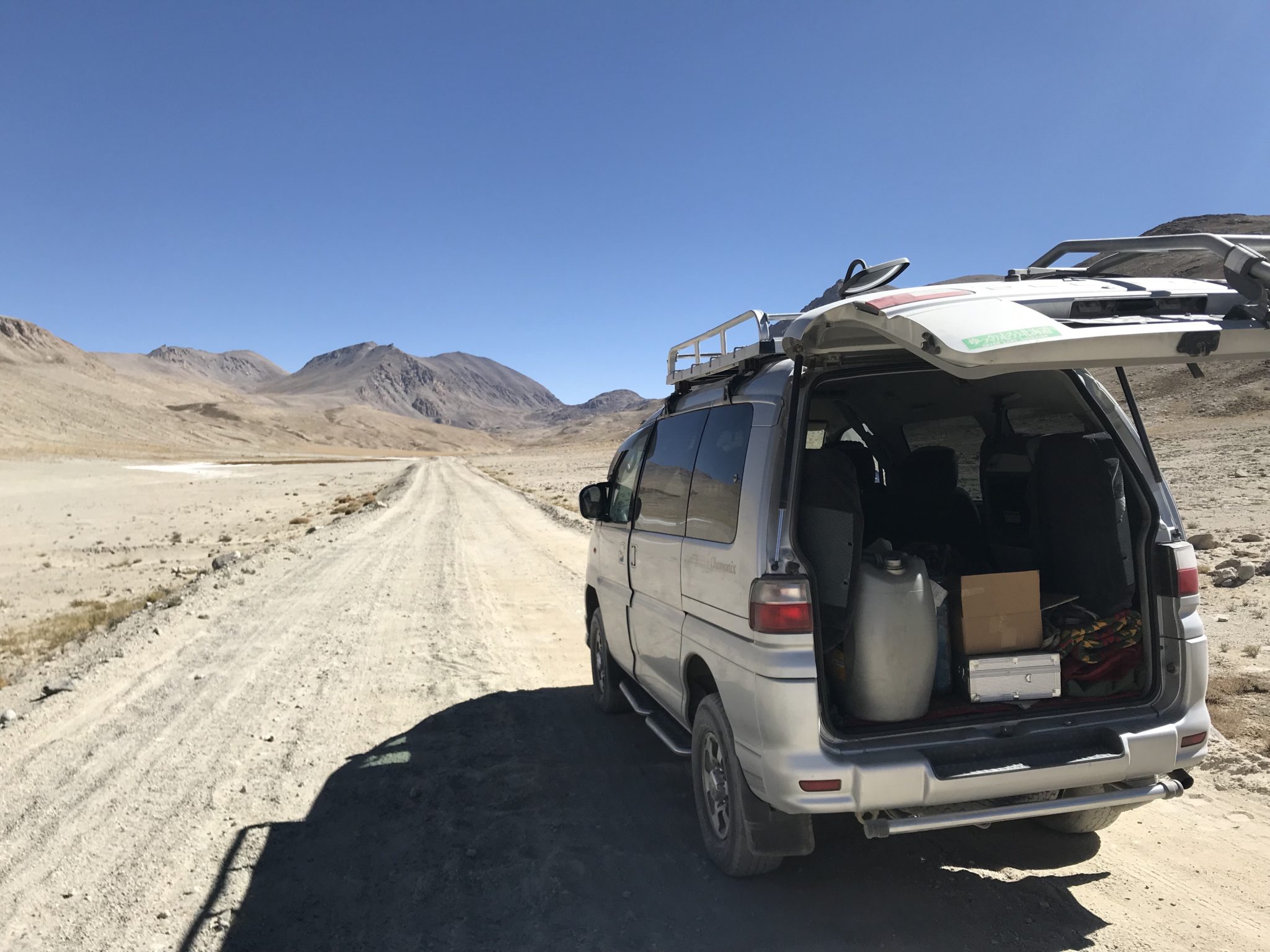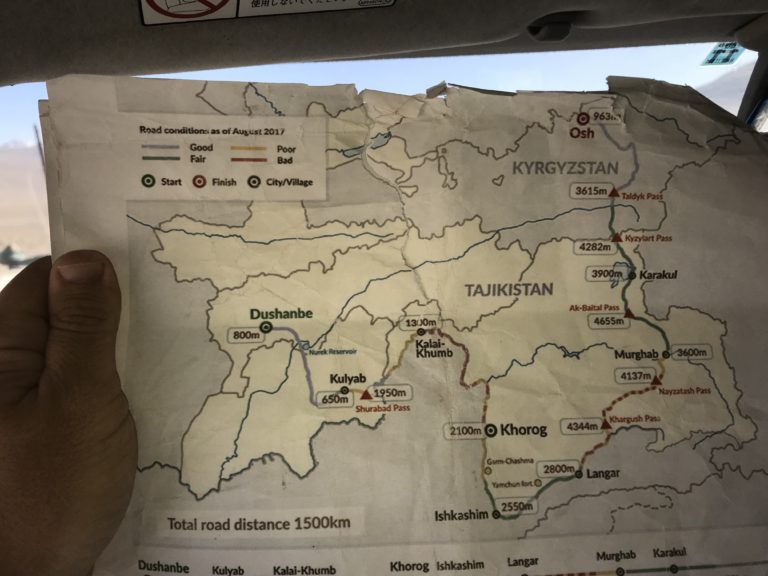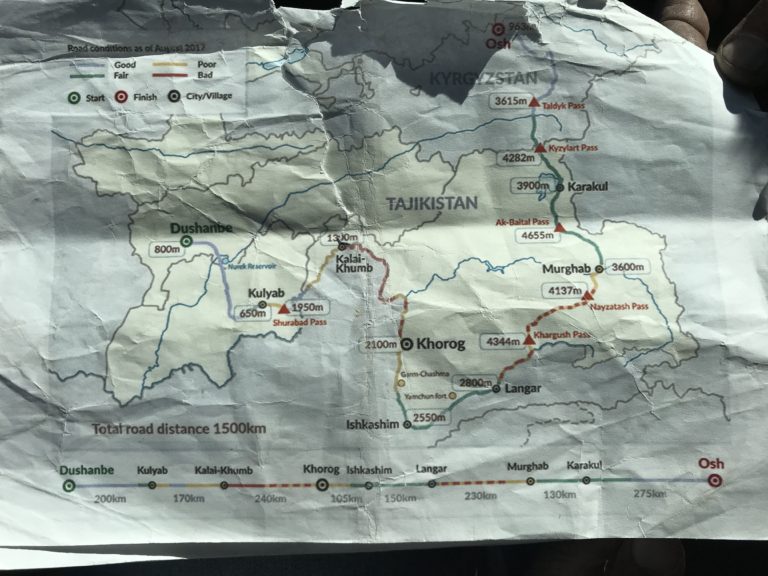Last updated on 04 January, 2019 at 10:48 am
1’500 km of rugged and dirty trails with breathtaking scenery – welcome to the Pamir Highway, one of the world’s highest highway!
You will cross vast plains at more than 4,000 m high surrounded by higher mountains that look down on you, narrow canyons overhanging with threatening rocks and a river turning into a torrent and forming the border with Afghanistan.
Linking Osh (Kyrgyzstan) to Dushanbe (Tajikistan), this road is one of the must-sees of the region.
Warning: Pamir Highway is an adventure that will put you out of your comfort zone. When reading the text below, you may feel that we didn’t like this trip. This is wrong, we loved to live this adventure! However, I don’t think we will do it again. 😉 It is highly recommended for adventurers as well as people who can give up their little comfort for a few days.
As we were in Kyrgyzstan, we started our journey in Osh. We went to the Osh Guesthouse, known for connecting travelers who want to share the cost of travel through the Pamir Highway. This is where we stumbled upon Sid, an Indian tourist who aimed to join Korogh in three days, just like us – yes we are aware that it’s a lot of kilometers per day but we didn’t want to spend too much time neither. Since most travelers seek to spend 10 days on the road, we were really lucky to find a hurried adventurer like us.
Lenin Peak
Our first stop was the Lenin Peak, a magnificent snowy mountain with a yurt camp and a beautiful blue lake at its base. Having already tested the yurts in Kyrgyzstan during our horseback ride, we didn’t spent the night there.
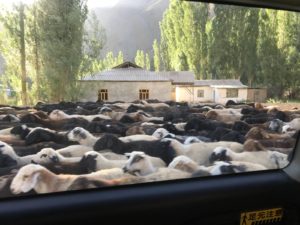
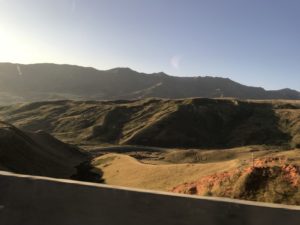

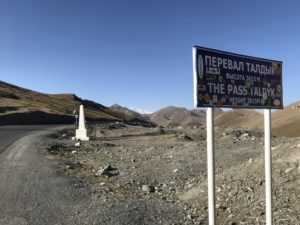
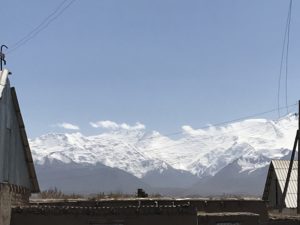
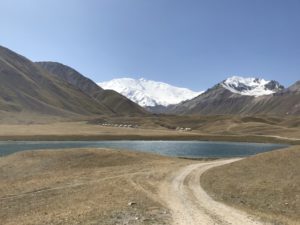
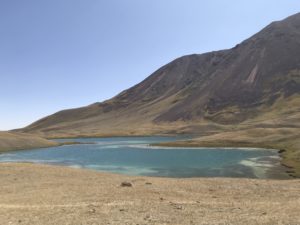
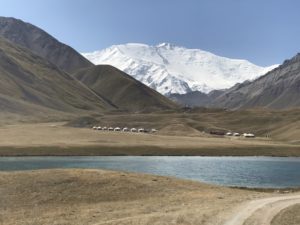
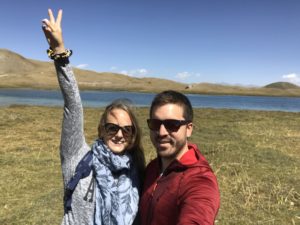
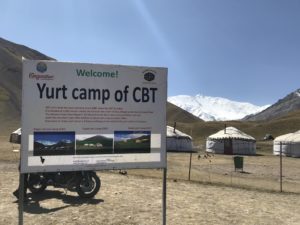

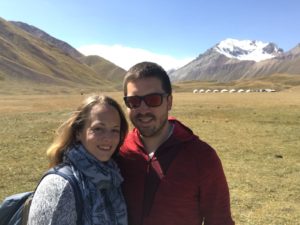
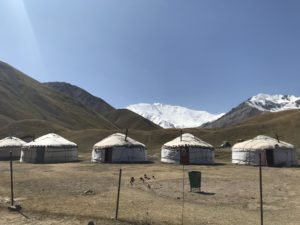
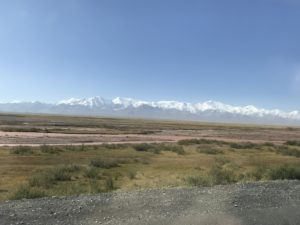
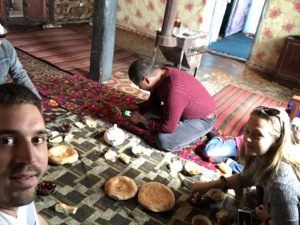
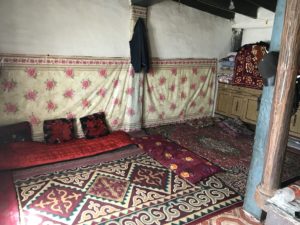
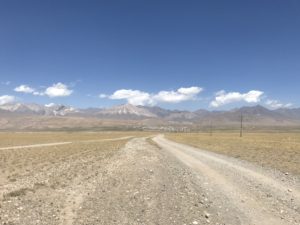
Crossing the Tajik border
We then continued towards the Tajik border. The crossing of the Kyrgyz border happened quickly, the bread and fruit brought by our driver did probably helped. The guy controlling our passports even flirted with Céline and told her that “in Switzerland, all girls are pretty like her” – I didn’t like it … if he didn’t have the power to block me and probably to put me in prison …! We then drove about twenty kilometers of no man’s land as the two countries don’t agree on the exact route of the border.
We arrive then at the Tajik border and are ready to spend there up to several hours according to the stories of people having made the same adventure. Our driver hands out fresh breads and fresh fruits from his trunk for the various customs officers. Our visas and passports get controlled by customs officers, then by the police, everything goes like clockwork – to our astonishment.
Once arrived at the exit, things go wrong, not because of the customs but because of the puddle drawing under our vehicle… After a quick diagnosis, the problem is found: engine coolant leakage… While our driver tinkers on the car, we are invited by a customs officer to eat with him in his cabin. He explains that he is from the police by showing us his knife and gun hidden under his bed and that he has about 20 days to spend up there before returning to the plain. We understand better how can fruit and fresh bread be enjoyed when you are stuck in the middle of nowhere for 1-2 months.
As the exact source of the leak can not be found, our driver fills the water tank with water hoping that it will be enough for the trip to Murghab – our destination of the day.
The passage to the customs will finally lasted 1h30 including 45 minutes due to the breakdown. Express time despite everything.
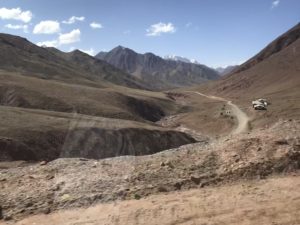
Murghab
As the leak was not clogged, it didn’t take more than 15 minutes to see the engine temperature rise again. So we made the last 150 kilometers to Murghab stopping about every 15-20 minutes to refuel the motor cooling tank. Fortunately for us, many streams flow in the area where we could fill bottles and jerricans otherwise we would still be there…

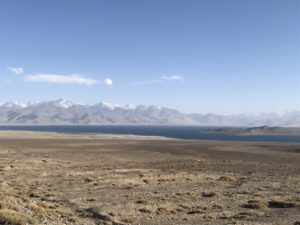
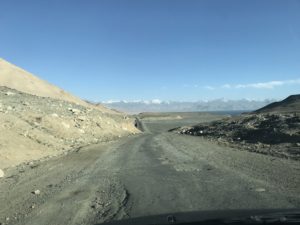
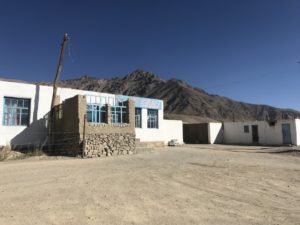
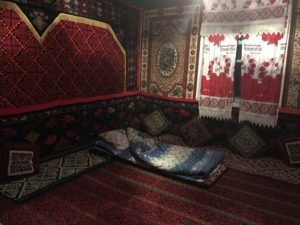
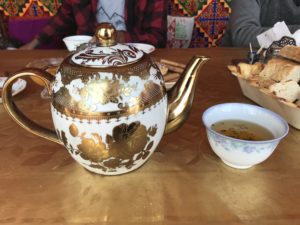
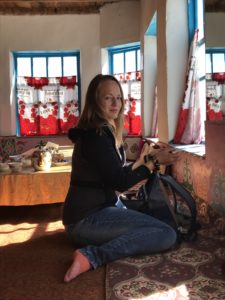
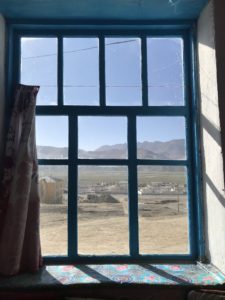
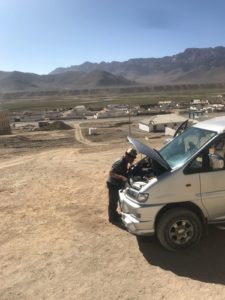
Murghab-Yamchun
The next morning, our driver was able to find the origin of the leak: a pierced pipe along the circuit. Our evening host was able to provide him with a replacement piece and we were able to leave. Here, everyone has manual skills and knows how to turn into a mechanician if needed.
We went from Murghab to Yamchun via the Wakhan corridor. It was during this part of the journey that we started to follow the border with Afghanistan. The two countries are separated only by a river flowing at the bottom of the valley. The various checkpoints have each received their fruits and bread when checking our passports and visas.
At the end, it looks more like tolls than police controls… The landscapes are breathtaking, the valley is sometimes wide and flat, sometimes narrow and steep depending on the terrain and erosion. The river grows as its affluent flow into it.
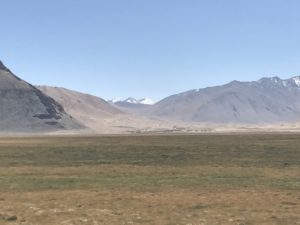
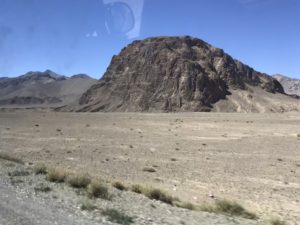
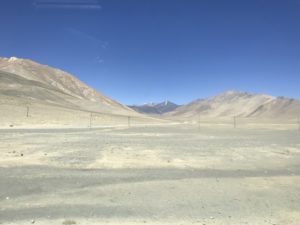

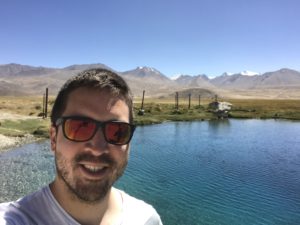
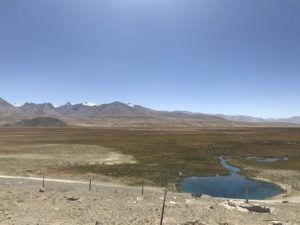
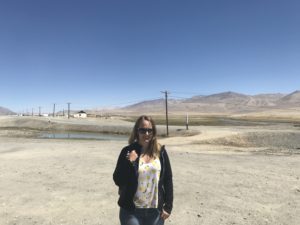
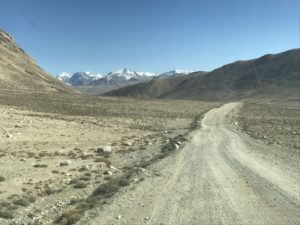
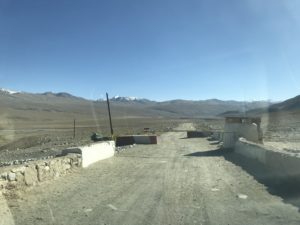
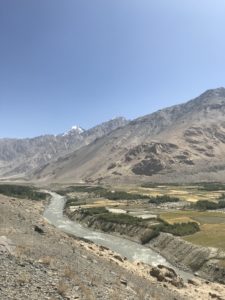
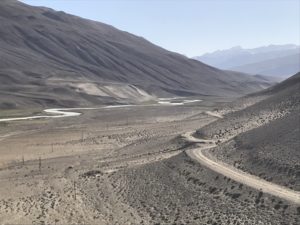
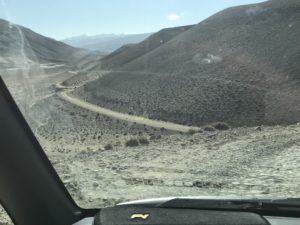
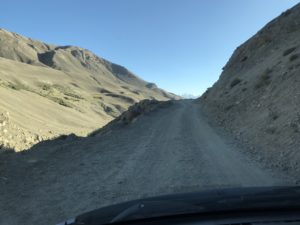
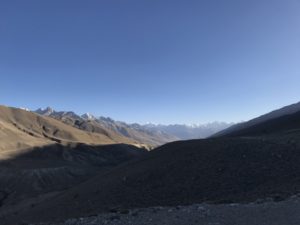
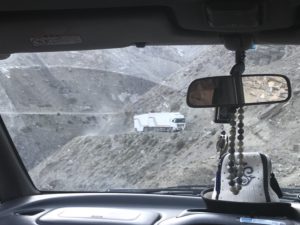
Yamchun - Korogh
We started our third and last day with a visit of the Bibi Fatima thermal baths. Forget what you know about thermal baths in Europe or elsewhere. Here, we go back to basics, the thermal water coming out and flowing directly from a cliff with a small basin to retain a bit of water – very very hot. We bathe naked, men and women separated. The women’s pool looked more like a standard pool than the natural rocks found on the men’s side. Do not count more than 20 minutes on there, in the end there is not much to do.
We then left to reach Korogh our final destination.
On the way, we had our second breakdown. Part of the suspension of the left rear tire decided to give up after too much suffering. With the help of another vehicle which had the right tools, the part could be repaired in about 45 minutes and we were able to finally reach Korogh.
Despite having a university, Korogh is very small and it is useless to linger there, except to recover from the Spartan conditions of the trip. This is where our path separated from the one of our Indian friend, returning to Osh with our driver.
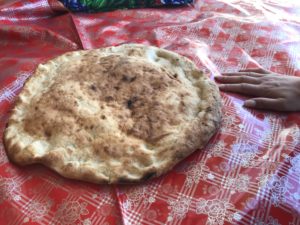
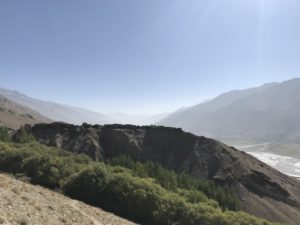
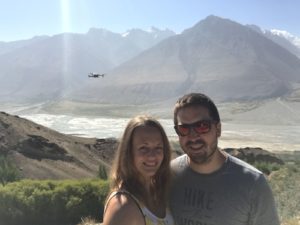
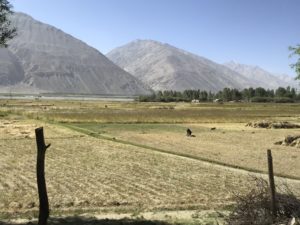
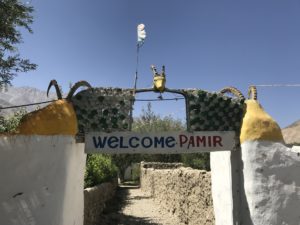
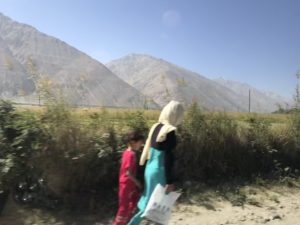
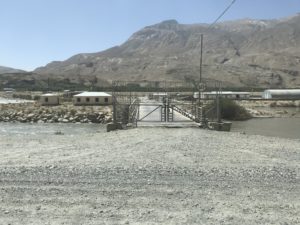
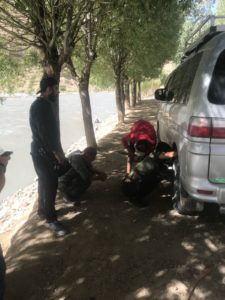
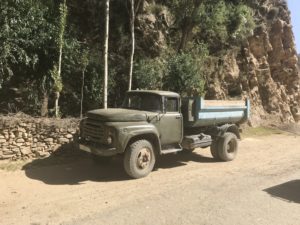
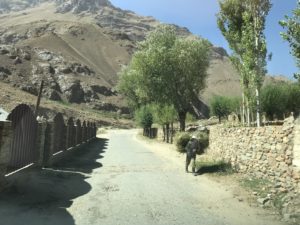
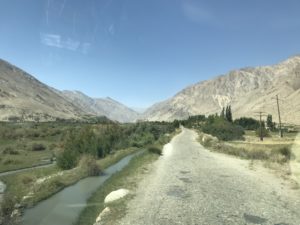
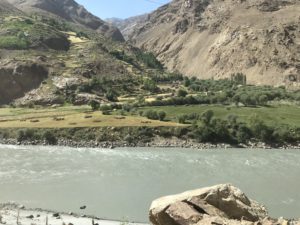
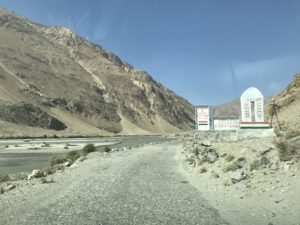
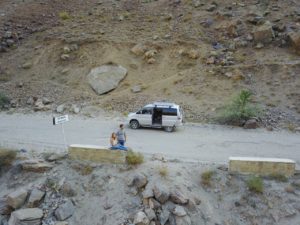
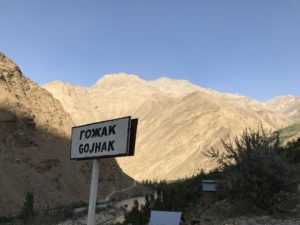
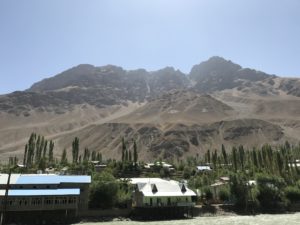
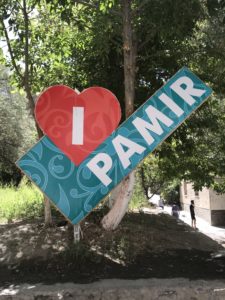

Korogh - Douchanbé
Depending on what you negotiated with your driver, you may need to arrange the Korogh-Dushanbe trip otherwise (which was our case). We took a shared taxi with locals (which is significantly cheaper than with a private car).
While looking for the location from which shared taxis leave and being misinformed, it was finally the taxi that found us. Since he had only us as passengers, he wanted us to join an already overcrowded car. There were no way that our bags and us could fit in that car, thus we refused to get in the car. As a result, the driver took us to the starting point and “sold” us to another driver with a car almost full and in which we were offered two seats a seat and a half at the front of the vehicle. Once again, it is useful to be a little demanding in these countries in order to have (sur)vivable conditions.
As for the marshrutka in Kyrgyzstan, the taxis leave once full, so as we finished filling the vehicle, we left soon after for 14h of drive.
After about 6-7 hours of drive, we heard a big boom from the front of the vehicle: the engine coolant tank (again !!!) had exploded! Self-help between drivers was pretty amazing: at least 5 cars stopped to help us. In 1 hour, a mechanician from the neighboring village was there, with the right spare part and the tank was reassembled. The tubes still had to be purged – with the color of the liquid coming out, no wonder why nothing was going through – and we were able to leave again.
We weren’t at the end of our surprises: during a steep climb, the engine began to overheat. So we had to stop at night in the middle of nowhere to cool the engine. Fortunately, a vehicle passing by stopped and went to get us some real coolant to fill the tank. This was not enough, however, and the engine warmed up again a bit later. It was finally after the intervention of a third driver that the engine returned to normal operation. We finally arrived in Dushanbe after 17 hours instead of the 14 planned – where a horde of taxi was waiting for us… And since it was 3am, no other choice to negotiate with one of them – and of course to pay way too much…
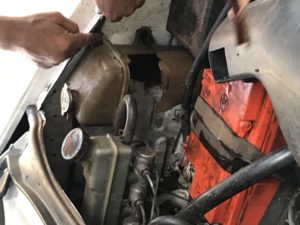
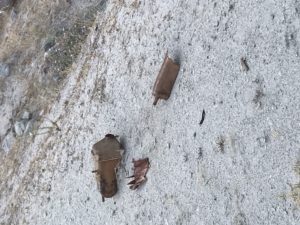
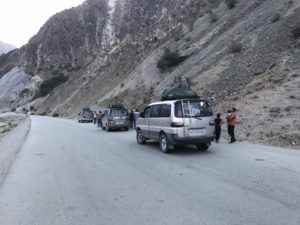
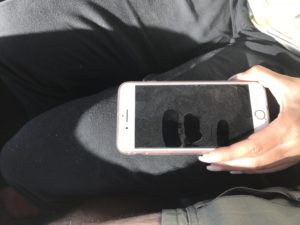
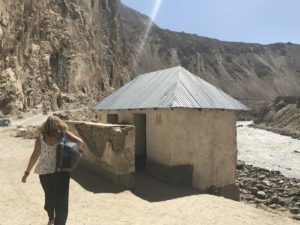
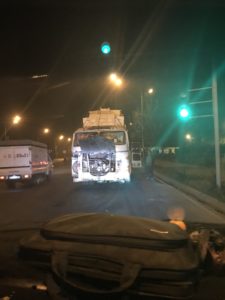
Pratical advices
You can cross the Pamir Highway by 4×4, bicycle, shared taxi or truck, in 3 as well as in 15 days.
The most interesting and exotic part is between Osh and Korogh. You can travel it in one way or the other.
If cycling, it is rather recommended to leave from the Tajik side because the ascent is more gradual. Indeed, between Osh and Murghab, one goes from 960m to 3’600m with a passage to more than 4’000m.
If you are leaving from Kyrgyzstan, it is recommended to take a car with the steering wheel to the right. Therefore, one of you will be sitting in front left, ideally placed to enjoy the view along the Wakhan corridor, as the view is mostly to the left of the vehicle. Conversely, from Dushanbe or Korogh, we recommend a car with the steering wheel on the left.
Departure from Osh
To find road partners in Osh, you can go to the Osh Guesthouse, where a board displays current opportunities to travel in the next days. No need to stay there to get access to the board.
Forums are also a good way to find an local organizer or people to share the car.
Prices - journey, food and accommodations
We negotiated the trip for three days for $550 for 3 persons – note that the trip from Kyrgyzstan is supposed to be cheaper because fuel is cheaper there. Meals and nights were not included.
The nights on the road cost $15 per person per night with evening and morning meals included (or $30 for a “double room” in which you may still sleep on the ground, with a cabin a little further serving as “toilets” and without shower…). This is excessive for what you get but it is difficult to do differently… I believe that by bicycle, it must be easier to negotiate and looking at the routes and distances, taking a tent is probably a very good idea .
Lunchtime meals are taken in restaurants along the road and are relatively cheap. We paid about 15 somoni (1.50CHF, 1.35 € or $1.50) per person per meal.
Entrance to the bath costs 10 somoni (1CHF, 0.90 € or $1) for tourists, 2 somoni for the driver and 1 somoni for the locals …
Accommodation in Osh
In Osh, we made the first night at the Silk Way Boutique Hotel. A three-star hotel in the north of the city, close to the airport. It was our criterion of choice since we arrived by plane late from Bishkek. The hotel does the job nothing more. In our experience, we start to notice that this kind of hotel does not offer a superior service to a good guesthouse but is usually more expensive.
The second night we went to Hostel Nur. It is a guesthouse further south of the city. The reception is very nice. We live in an annex at the main house. And, rare thing, you can do the laundry for free, handy before starting the Pamir Highway.
Accommodation in Korogh
Arriving at Khorog, the driver took us directly to a homestay. If you want to go to the one of your choice, you will have to tell the driver beforehand.
Visa for Tajikistan
To enter in Tajikistan, you need a visa.
The simplest is to apply for an e-visa that costs $50. If you want to go to the Pamir region, do not forget to ask for the GBAO pass on the visa application. It costs $20 more but is needed to enter this area. An answer is obtained within 3 days.
In the FAQ of the webpage, it is mentioned that you must enter the region of GBAO on the exact day of the beginning of validity of the GBAO pass while for the rest of the country, you have 45 days from the date of the beginning of the visa. In practice, the e-visa has only one date: the one of entry into the country. From our experience, the 45 day date is the rule as we entered without problem at a different date of the beginning of validity of the visa. It was a point that scared me before we crossed the border because I hadn’t found any information on the internet.
Korogh
In Korogh, no ATM works with a foreign card. We tried with a Maestro, Visa and MasterCard on at least 5 different ATMs (almost all those in the city center) without success.
Dollars can be exchanged at a bank (banks are closed on Sundays). All the places where we slept accepted to be paid in dollars. So think about having enough with you. Restaurants in contrary want to be paid in somoni. Withdraw or change in Osh before leaving. Locals also agree to exchange dollars for somoni. Look for the current exchange rate beforehand. We use for that the XE Currency Converter app.
You can go to Dushanbe either by shared taxi (300 somoni per person, or 30 CHF, 27 € or 30 $), with a small plane (cost about 200 $ per person), or with a private car (one asked us 100 $ for the trip!).
In contrary to what the maps.me application displays, the departure of the shared taxi for Dushanbe is not in the bazaar but close to the airport. A taxi to get you there will cost you 3 somoni or if you hang around long enough on the side of the road, you may have a shared taxi that will stop and take you directly there from the city, which happened to us by chance.

